Mykonos is the jet-setter of the Cyclades. It fuses the vibes of the Cote d'Azur with a touch of hedonism a la Ayia Napa, bringing together a diverse crowd of shoppers, villa goers, LGBTQ+ partiers, and dedicated sun worshippers. It's pumping with life in the summer months but can feel almost abandoned in the winter. There are scintillating beaches backed by uber-cool chillout clubs next to creaking windmills that have stood since Venetian times.
This guide to Mykonos will run through everything you need to know if you're planning a jaunt to this chic and stylish spot in the Cyclades chain. It's got details on the best time to travel, the top things to do, the finest Mykonos sands, and how to get there in the first place. Let's begin…
Where is Mykonos, Exactly?
Mykonos is near the very heart of the iconic Greek Cyclades, a chain of islands that stretches from the edge of Attica to the middle of the Aegean Sea. Its nearest neighbour is uninhabited Delos. But the closest occupied island is Tinos, which sits just under six miles to the northwest. Some of the most famous islands in Greece are a little to the south of Mykonos – Naxos, Paros, and Santorini. That's what makes this one such a popular pitstop on island-hopping trips through the region.

When to Visit Mykonos
Life on Mykonos ebbs and flows with the changing of the seasons. Winter can be all but deserted, with just a few stray cats stalking the cobblestone streets of Chora town. The first people start to come around April time, before a mega boom in tourist numbers in June. Things don't wind down again until September or October. For those reasons, we'd say that the best time to visit is mid-spring or autumn, when there aren't so many people, but the weather is still beach-worthy.
Mykonos in Winter
Here's the thing – there's not all that much to do in Mykonos in the winter. The only real upside of coming between November and March is that there aren't so many other people on the island. Oh, and it's cheap! But there's a reason for that. Temperatures average around 14-16 degrees most days, but the wind and rain can be regular. The Aegean is also pretty rough, so long, lazy days on the beach are probably out. On top of that, the Chora town (and its vibrant bars) goes into hibernation mode. TL;DR: This isn't the season to come island-hopping to Mykonos!

Mykonos in Spring
Average daily temperatures on Mykonos go from 19 in early April to over 23 at the end of May, making this the first part of the year that you can hit the sands of the popular west coast without shivering. Evenings can still be a touch chilly and there's a little more rainfall than in the upcoming summer, but that's balanced out by smaller crowds and lower flight and ferry prices. Sea temperatures are about 16-17 in the spring, so it's refreshing but swimmable.
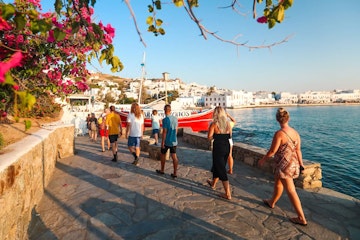
Mykonos in Summer
Season-opening parties commence in the Chora bars and the Paradise Beach clubs around early June. They kick start a string of three months when the average daily mercury levels hover between 27 and 29 every day. There's also hardly a drop of rain to match that. If that sounds like the perfect time for Mykonos to get on its party shoes – that's because it is. This is the top season for enjoying the hedonism and the luxury lifestyle that the island is known for. Just be warned that prices will be at their highest.

Mykonos in Autumn
We're going to go out on a limb in this guide to Mykonos and say that autumn is actually the best time of all to visit this happening part of the Cyclades. Visitor numbers noticeably decrease the moment that August switches to September, but temperatures only go down one notch to average 25-26. What's more, the Aegean is positively balmy, enjoying waters of over 20 degrees after a summer of being baked from above. October isn't quite as warm but still has its charms.

Things to Do in Mykonos
Mykonos is often hailed as the ultimate good-time island. It's a place to crank up the R&R, chillax with a cocktail, swim, sunbathe, and snorkel. You will also find some fascinating historical sites thrown in for good measure, not to mention a nightlife scene to rival Ibiza…
Little Venice
Prepare to be enchanted by Little Venice. This bijou quarter of Mykonos Town is wedged between the aquamarine waters of the Aegean Sea and the maze-like heart of the Chora. It's a hubbub of life from morning until night, as cafés and bars spill out onto salt-washed balconies where people clink cappuccinos and cocktails. You'll need to get in early to get the coveted seats by the water's edge. They have a view across the west coast with the historic Venetian windmills dotting the horizon.### Party and then party some more Mykonos isn't considered one of Greece's top party islands for nothing. Nope – there are more bars and beach clubs here than you can shake an ice-cold ouzo at. The thing is, the parties rarely seem to end in the summer months. It's more a cycle of drink, dance, sizzle off the hangover at the beach bar, then repeat. You can either choose one of the party beaches or head to Chora town, or do a mix of the two. Stand out spots include Super Paradise Beach (arguably Mykonos's best-known LGBTQ+ scene), Paraga Beach (mellow days, mellow nights), and venues like Cavo Paradiso or Scorpios on the south coast.
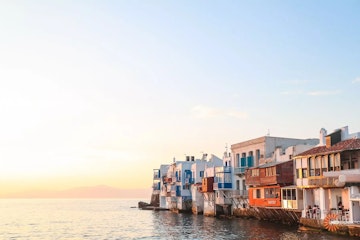
Party and Then Party Some More
Mykonos isn't considered one of Greece's top party islands for nothing. Nope – there are more bars and beach clubs here than you can shake an ice-cold ouzo at. The thing is, the parties rarely seem to end in the summer months. It's more a cycle of drink, dance, sizzle off the hangover at the beach bar, then repeat. You can either choose one of the party beaches or head to Chora town, or do a mix of the two. Stand out spots include Super Paradise Beach (arguably Mykonos's best-known LGBTQ+ scene), Paraga Beach (mellow days, mellow nights), and venues like Cavo Paradiso or Scorpios on the south coast.

The Mykonos Windmills
The windmills of Mykonos are a regular appearance on postcards of this sun-splashed island. They're one of the most iconic sights in the area, peering over the hillsides above the hustle and bustle of Chora's handsome Little Venice area. The best time to see them is at sunset, when a glow of ochre-orange light blazes into the bay and crowds of people head up to enjoy the view. The windmills themselves are no longer in use but have a history that dates back all the way to the Venetian era in the 1500s.
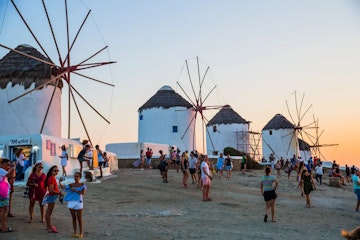
Day Trip to Delos
Calling all history buffs – Delos is just over the strait from Mykonos and it's a must for anyone interested in the long, ancient past of Greece. The island was once a major forum, sanctuary and treasury for an alliance of Greek city states that was eventually transformed into the Athenian Empire. The gods Apollo and Artemis were revered here and the remains of great temples to them still stand. You'll also see the ruins of a huge theatre and the iconic Terrace of the Lions, which was constructed as far back as 600 BC!
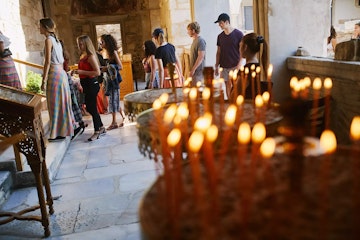
Explore the East Coast and the Backcountry
It's no secret that Mykonos is one darn popular island. But a large proportion of the crowds that come here rarely leave the trodden spots of Chora and the south- and west-coast beaches. You can do that by renting a car, or – better yet – and ATV quad and hitting the roads. They weave and wiggle out away from the marinas into a backcountry of scrub-clad hills and jagged mountains, through lost villages of whitewashed cottages and mysterious Orthodox churches. Adventures in these lesser-known parts of the island could include a stop off at the Vioma Organic Farm for homegrown field-to-table food or a jaunt through the Profitis Ilias reserve, which is filled with pristine coves where there's sometimes not another soul in sight.

The Best Beaches in Mykonos
Mykonos has no shortage of stunning beaches. The bulk of the most popular spots string along the southern and western shorelines, within easy reach of Mykonos town (Chora). They tend to be built-up with pumping beach bars and apartment complexes. However, there are also spectacular sands up on the north coast, while the east is mainly given over to rugged coves and inlets.
Paradise Beach
Paradise Beach is the party hub of the south coast. It's flanked by a duo of the most iconic beach bars in Greece - Tropicana on one side and the Cavo Paradiso club on the other. That ensures there's a continuous flow of beer-guzzling revellers in this direction, which is only increased thanks to the regular bus out of Chora. The beach itself has pristine white sand and runs for about 300 metres from end to end. There's good snorkelling in the reefs to the east and sunbeds for rent further west.
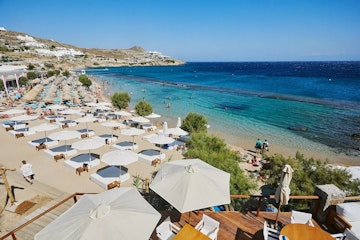
Paraga Beach
A horseshoe bay that's hidden between two long headlands on the south coast of Mykonos, Paraga Beach is another party haven. Only here the vibe is distinctly more upscale, with venues like Scorpios capping the cliff tops with their boho-chic mix of décor and design. Paraga Beach has plenty of sunbeds and gets bustling every day in the summer. The water is super clear and there's a central dash of rock reef where you can swim with schools of multicoloured fish.
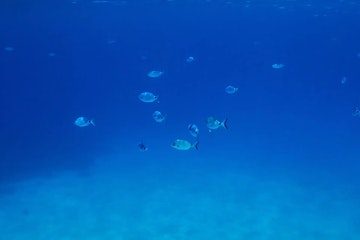
Elia Beach
Elia Beach takes you a little further east from Mykonos Town, but there are still direct buses on offer. What's more, this is one of the longer sand stretches on the south coast, which cranks up the square meterage and means you can usually find somewhere a little more secluded. The east end of the bay is for topping up the tan au naturel. There's not much snorkelling on offer at Elia but the swimming is great, thanks to a south-west orientation that keeps the waves small. There's also a speckling of gorgeous villas with pools on the hillsides just above.
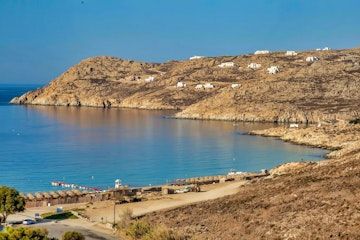
Psarou Beach
Get your celeb spotting skills up to scratch by hopping down to Psarou Beach. This is where the A-listers head on Mykonos. It's by far the most upscale beach on the island, so expect to see the outline of a few sumptuous yachts moored along the headlands. A row of luxury bistros – the best of which is certainly NAMMOS – backs the sands, while sunbeds and umbrellas fill the foreshore from May until October.

Agios Sostis Beach
Agios Sostis Beach is for those who really want to escape the crowds. It's hidden away on the north coast of Mykonos and is reachable by car, although an ATV is better. The sand rolls in a C-shape between two rugged headlands coloured with rust-red stone. There's a small village at one end where you'll find a taverna, but the beach itself is rarely busy. Swimming at Agios Sostis is usually wonderful thanks to a low and sandy shelf, although the swells can get up in the winter months.

How to Get to Mykonos
Mykonos is one of the easiest islands in Greece to get to. Not only does it boast its very own airport but it's also one of the main transport interchanges of the central Aegean, with ferries coming and going from Athens and nearby Cyclades like Santorini…
Mykonos Flights
Mykonos International Airport (JMK) now handles upwards of 1.5 million passengers each year. It's been in operation since 1971, but has only recently expanded to host a whole range of low-cost and premium seasonal arrivals. The keyword there is seasonal – a lot of the links in and out of Mykonos only run from the spring to the autumn.

Popular connections into Mykonos International include:
- Aegean Airlines – Domestic routes to Athens and Thessaloniki, but also international links to Paris and Milan.
- EasyJet – Affordable budget carrier with lots of seasonal connections to the UK.
- **Wizz Air **– A European low-cost carrier with direct flights from Mykonos to Abu Dhabi, Poland, and Hungary.
- British Airways – UK flag carrier with lots of seasonal connections in from London.
Mykonos Ferries
Here's a guide to Mykonos ferries that includes a number of the most popular routes over to the party isle. There are a few ways to get in from Athens – including using the shorter links from the port of Rafina. But you'll also find oodles of cross-Cyclades connections that make it easy to plan an island-hopping itinerary that includes a pitstop at the windmills and beach clubs of Mykonos…

- Athens to Mykonos (€37-50 / 3h15-5 hours) – The most popular way in from the Greek capital, but you'll need to get to Piraeus port first.
- Rafina to Mykonos (€29-52 / 2-3 hours) – A fantastic alternative for getting from the Athens region to Mykonos. It's usually quicker to this port from Athens airport and the ferry connection is faster.
- Santorini to Mykonos (€60-70 / 3-4 hours) – A popular route that runs roughly once daily, going from the famous honeymoon island of Santorini to Mykonos through the heart of the Cyclades chain.
- Crete to Mykonos (€60 / 5 hours) – A single ferry line that goes once per week links up Crete with Mykonos. It's run by Minoan Lines and leaves from the port in Heraklion.
This guide to Mykonos covers all the basics of what's now considered Greece's favourite jet-setter and LGBTQ+ island. If you're tempted by the stunning bays and the buzzy nightlife, be sure to get in touch for info on island-hopping trips that include a stay in Mykonos.


